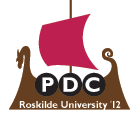| EXPL PAPERS | THURSDAY 11:00-11:45 | GRAND AUDITORIUM |
Collaboration
Session chair: Toni Robertson, University of Technology Sydney
Social media as a platform for participatory design
Lill Francis M. Reyes, University of Oslo
Sisse Finken, University of Oslo
Abstract. In this paper we explore social media as a new arena for participation. The explorations are informed by an ethnographic oriented PD project that follows a PD method and its process of translation within a digital setting. This process is exemplified through outcomes from a Future Workshop that unfolds on Facebook with a group of participants who feed in to a new design of a digital photo-archive on mobile phones. With an explicit focus on translation and use of this PD method the paper presents experiences and challenges encountered during the process in this emerging PD environment. Within this, the paper looks at facilitation of distributed users, heterogeneity of users, and fluidity of participation. In subjecting the experiences and challenges to related works the paper sheds light upon matters that can serve as resources for future translations of PD methods.
Artistic participatory practices as a vehicle for togetherness
Rosanne van Klaveren, Media, Art, Design Faculty, Belgium
Abstract. In all its functions and possibilities art has the option to be more embedded in societies, in dealing with social and political issues, than ever before. For example, community art became a common art practice during the previous decennia: artists temporarily work within communities to create art together with participating citizens. Also in design and design research we see a growing use of participatory practices in which the knowledge, experience and creativity of community members are valued beyond inspiration. But how can artists deal with the notion of togetherness when they are outsiders to the communities they work with? How can they overcome the us-and-them dichotomy that is still a common handicap in community art and in other forms of artistic participatory practice? This exploratory paper discusses some conditions that can help in the creation of a temporarily ‘we’ during participatory practices. Anthro-pological approaches and design methods are brought together with self-discovered insights of the artist-writer, picked up during many years of participatory practice and her artistic PhD research involving Arctic indigenous communities.
A framework for understanding outcomes of mutual learning situations in IT projects
Magnus Hansen, Roskilde University
Abstract. How do we analyse and understand design decisions derived from mutual learning (ML) situations and how may practitioners take advantage of these in IT projects? In the following we present a framework of design decisions inferred from ML situations that occurred between end-users and stakeholders in two participatory design workshops. The participants of the workshops were tasked with redesigning the graphical user interface (GUI) of an electronic ambulance record (EAR). Users participated primarily in the first workshop while stakeholders as well as users participated in the second. We identify the concepts of actionable and volatile ML situations that may result in solidification of a decision of either the design of the artefact or the development process. These concepts are applied post-hoc to four exemplary ML situations that occurred during the workshops: a) a ML situation where design issues of ease of use were solved by users; b) a situation where usability issues beyond the users’ grasp were identified in the first workshop and solved by stakeholders and users together during the second workshop; c) and d) situations where usability issues were solved by the users in the first workshop but not discussed with stakeholders despite the fact that the users had proclaimed that the redesign could have consequences for the stakeholders in the long run. By applying the framework to the ML situations as we define situation “a” and “b” as actionable and situation “c” and “d” as volatile.
